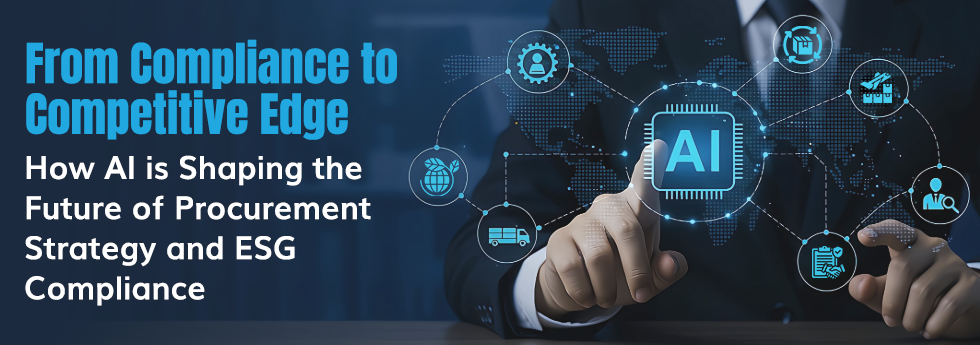As we start the new year, it’s important to bring focus back on a key topic that remains a critical area for organizations. Geopolitical issues may have slightly pushed the climate change agenda a bit away from the limelight, however the legislative and compliance requirements are not going away and are likely to see a renewed focus in the coming years.
We can divide the impact of ESG on businesses into two aspects.
- The first is the affirmative action required to reduce emissions and contribute to reduction of the carbon footprint of the company.
- The second is the mandatory compliance requirements that are country as well as industry specific.
There are also regional or global regulations that need to be complied with. While the first may not impact all organizations equally, the second has a significant impact on all manufacturing / supply chain companies that have international business.
Inhaltsverzeichnis
ToggleThe increasing burden of ESG compliance
Compliance is getting more complex with each passing year, especially with the addition of supply chain compliance to the mix, especially in Europe. Being liable for a non-compliance occurring somewhere in your n-tier supply chain where you have little or no control is extremely challenging and without the use of technology to track (and discover the n-tier supply chain), it will leave you exposed to regulatory risks and in some cases extreme penalties. Since suppliers can be in any part of the world, maintaining a comprehensive supplier database and tracking compliance and risks across various locations may not even be possible for smaller manufacturers.
I’ll focus a bit on the second topic for the above reason as well as because we see a good convergence of new technologies and well-defined practices to achieve better outcomes and reduce the compliance burden on companies.
Using Digital Technology to manage ESG compliance
The good news is that technology offers a range of tools and platforms that help companies navigate the complex world of ESG compliance. Tools and technologies that can support a company range all the way from databases to specialized products that offer a complete solution from information gathering and risk assessment to compliance and reporting. The real game-changer is the increasing use of AI technologies to deliver greater value by reducing the burden of compliance in several ways.
Technology and data-driven ESG strategies
Aggregating ESG data is very complex, since the scope includes Human Resources, Health and Safety, Human Rights, Organizational Sustainability, Supply Chain Sustainability, Ethics, Environment, Conflict Minerals and Cybersecurity. Depending on the industry, more elements could be included. Additionally, Risks such as financial, environmental and geopolitical risks must be tracked to ensure a holistic approach. This requires integration with multiple data sources, possible IoT integrations for energy consumption, and other real-time information from the manufacturing site. The solution needs to be highly scalable to not only aggregate all data parameters but also process them at the required speed so that red flags can be raised for any non-compliance. Reporting is another area where technology can reduce the effort and complexity of processing all the information into meaningful KPIs that can be reported to the appropriate authorities.
Supply Chain Transparency
One of the greatest challenges, however, is ensuring transparency throughout and it must be measured and reported across the n-tier supply chain to track ESG compliance to avoid penalties. This is extremely difficult as not all suppliers are willing to transparently share their next levels of suppliers, or quite possibly they simply cannot identify suppliers beyond the first level. The Covid-19 pandemic demonstrated how supply chains can break down due to events beyond our control. While this is not strictly an ESG use case, ensuring Supply Chain transparency certainly helps in de-risking your business and minimizing large-scale disruptions. This leads us to the next topic.
AI and ESG
AI is pivotal in ESG through aggregation of global data and using semantic analysis and multiple other means to flag potential issues and predict possible risks to your supply chain. For example – a fire reported in a factory in another country or floods in an area needs to be correlated with one of your suppliers by matching information available only in the local language against your list of suppliers in that region. Maybe this needs to be crosslinked with your n-tier supply chain, since no direct supplier of yours has a plant there. Without the use of AI, this can become extremely complex and very expensive. Predictive analytics can further simplify this set of red flags into the ones that have the highest probability of impacting your supply chain. There are various other scenarios, like optimizing energy consumption, identifying human rights violations based on analyzing news reports etc. The smarter the system, the faster you can react and fix the issue before it hurts your business.
Integration with Business Strategy
With much greater consumer awareness of ESG issues, it’s no longer just a regulatory necessity, but also a competitive advantage. It is good business strategy to blend ESG goals into your overall manufacturing, sales and marketing plans. Leading companies are doing just that and reaping the benefits of customer goodwill and at the same time doing good for the environment. Cost of compliance can be flipped on its head to become a smart business strategy.
The bottom line is this: ESG compliance is no longer a checkbox to tick off—it’s an ongoing journey that demands innovation, strategic thinking, and the adoption of cutting-edge technologies like AI. By embracing these technologies, companies can ensure they remain compliant, sustainable, and successful in the years to come.



